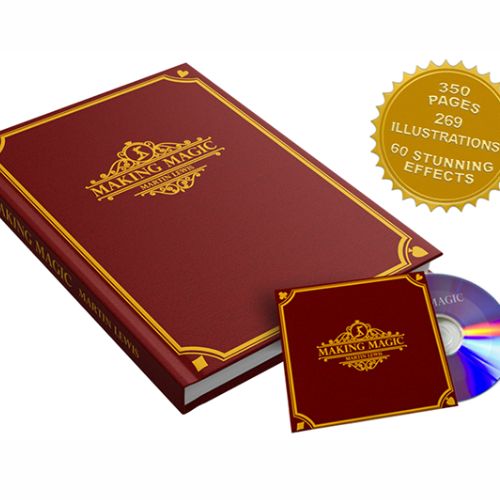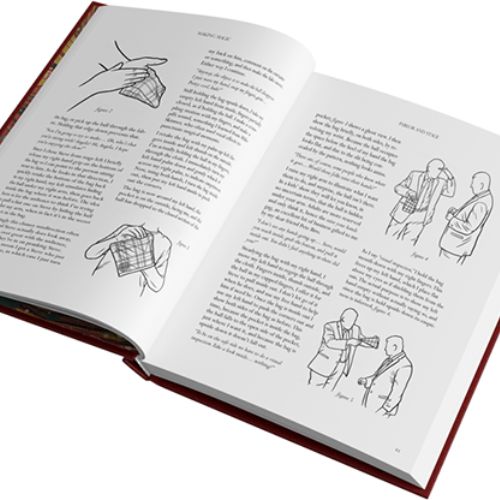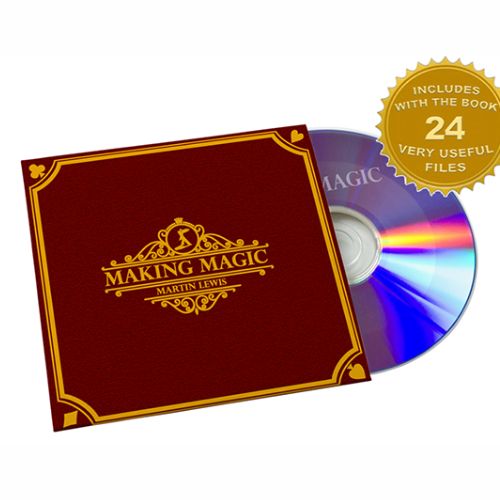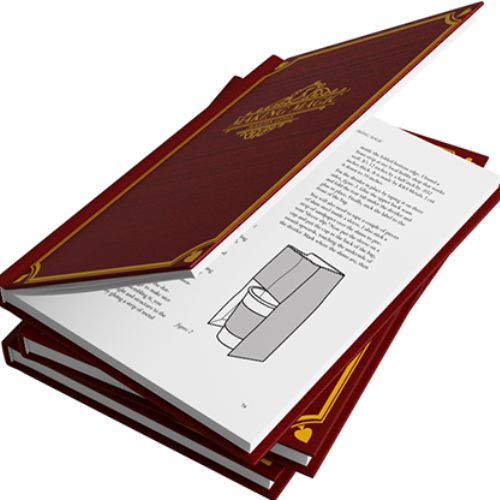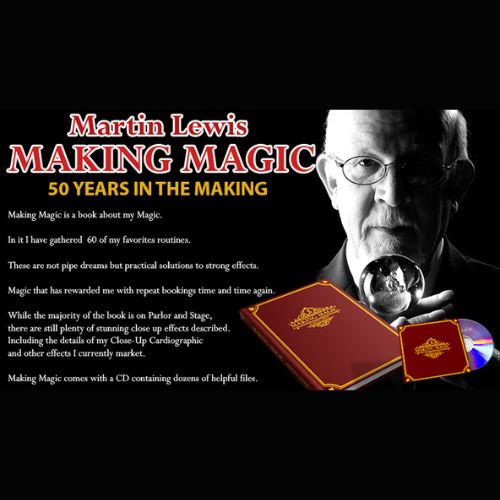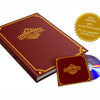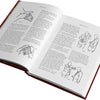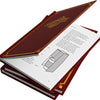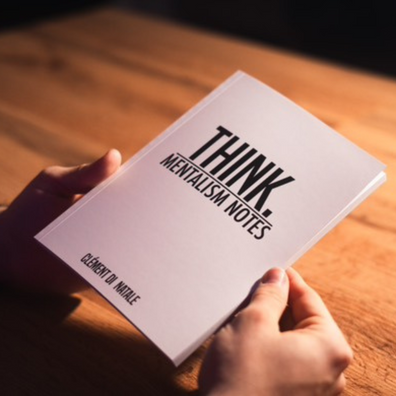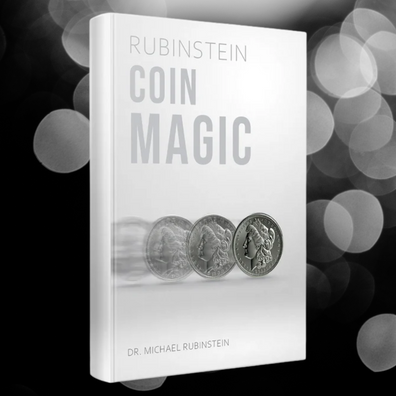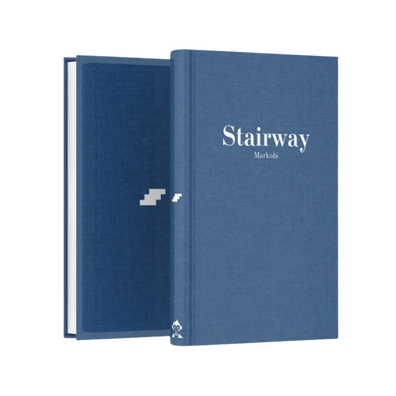MAKING MAGIC BOOK BY MARTIN LEWIS
martin lewis
Making Magic is a book on my magic. I gathered 60 of my favorite routines there. These are not chimerical dreams, but practical solutions for strong effects. A magic that earned me repeated reservations repeatedly. Although most of the book is devoted to the show and the scene, many narcotic closed-up effects are described there. Including the details of my close-up cardiography.
Making Magic contains equipment from my notebooks, conferences, magazine articles, videos and marketed towers. As my magic is constantly evolving, everything has been rewritten to update it!
Review:
"Making Magic is the kind of book that the world of magic does not often see; it targets high and exceeds its objective. Filled with high quality routines, writing and illustrations are exceptional. When you enter the subtle word game in the title of the book, you realize that a large part of the equipment requires a little construction and manual work so that the routines are born. This is why writing and illustrations are so important. I am not a big follower of DIY, but Lewis guides you with serene expertise! The towers themselves are of high quality and very commercial, many of them coming directly from the number of Martin or the list of effects marketed by his company. There is even a separate disc that contains the additional models and information you will need to build Martin's latest miracles. I highly recommend this book and think that it is intended to become a contemporary classic of magic. It is a wonderful example of how magic, methods and the way they are taught can blend into something really special. "
- Nick Lewin - Vanish International Magic Magazine
"Making Magic is a treasure of practical, commercial and confusing routines for the scene and the close-up. Each vital information is explained, including illustrations and construction diagrams, manipulation details and full-minded presentations of Martin. I could probably stop here; At this point, you know almost everything you need to know to make an intelligent purchasing decision, but I will give some additional details: sixty effects are explained in Making Magic; Thirty-seven are stand-up routines. If you have already tried to put on a stand-up show, you quickly realized that there is a shortage of quality stand-up equipment. This is why so many artists use the same routines ... In Martin's book, you will find new approaches to certain classic intrigues (for example, playing with your food, Martin's version of the Epic mental effect) . Admittedly, you will have to devote a little time (and/or money) to the construction of accessories, but if you do, you will get great routines than few other people execute. Finally, there are beautiful stories. Martin was fortunate to be on the west coast during the golden years of the Magic Castle; His memories of this time are scattered throughout the book. In particular, the stories of Vernon and Billiards, Lou Derman and the largest card tour ever made, and Harry Anderson and the animal trap are my favorites.
Here is the essential: if you do stand-up magic (whether or not you are a handyman), you need this book. If you are looking for close-up magic that will not break your feet, you need this book. Or if you just want to see how one of the greatest magic creators designs his miracles, you need this book. For what you get, the price is ridiculously low. Making Magic is one of the best magic books that I have ever read. Buy it, you won't regret it. I highly recommend it."
- Michael Close
"I wanted to tell you how much I like Martin's latest book. Almost every sentence contains incredible ideas. I can't read more than one chapter per day because they are all filled with wonderful information to absorb . I no longer count the number of times I laughed at Martin's comic replicas in explanations and scripts. A real joy".
- Todd Karr
"Martin Lewis surprised me and entertained during what seems to me to be countless years now. But also mystifying and entertaining whether the magician Martin is often during his conferences that he most Mystified and amazed, by explaining an apparently inexhaustible inventive creativity, doubled with a remarkable talent for building ingenious magic accessories, but often easy to make. Original stand-up magic richness that can help any reader build a more original and more distinctive number. The man who created "Cardiographic" presents to readers an inspired volume which is full of equally deceptive, original and commercial effects. Are you a worker? Do you want to be a worker? Do you want to stand out? "Making Magic" will show you how, with step -by -step instructions, downloadable support equipment, all presented by the full -minded and engaging voice of Martin, dotted with large anecdotes collected during a remarkable career. Did I like "Making Magic"? No ... I loved it!
- Jamy Ian Swiss
"Everyone knows Martin Lewis because he created the modern classics" Sidewalk Shuffle "and" Cardiographic ". Having won the Academy of Magical Arts prizes for the living room magician in the year in 2000 and 2001 and for the lecturer of the year in 2005 and 2007 did not harm the artist's reputation either. When he does not create, does not play and does not sell his commercial, strong and fun magic, Mr. Lewis haunts all hardware stores and art and craft stores located within a radius of 10 miles around his premises underground in California. Grain to grind without cunning for its magic mill. In Making Magic, Mr. Lewis teaches 60 of his best magic creations, taken from his conferences, his contributions to magazines, his videos, his marketed towers and his notebooks. Most effects use small accessories and are designed to be executed in a living room or on a stage. Fortunately, the author also included a few clever things for the close-up. Mr. Lewis rewritten all the material previously published to update it. The author writes well, is maliciously funny and does an excellent job of teaching his equipment. It provides the appropriate references. Mr. Lewis Intercale The effects with anecdotes on his life as a magician. The illustrations are attractive and pleasantly complement the text. To make an entertaining show, Mr. Lewis considers that personality is the most important factor, followed by the presentation, the effect and finally the method. This is why most effects include its presentation or a captivating script. The book is beautifully designed and produced. Mr. Lewis includes a CD containing dozens of attractive drawing files and clear plans necessary for the construction of accessories. Yes, I said "accessories" construction.
The title of the book is literal. To make most of the effects of this book, you must make magic accessories. Now don't start complaining and don't stop reading! With the exception of a few accessories that require special materials and professional manufacturing, the construction of accessories is not difficult. You don't need special skills. However, the clear instructions of Mr. Lewis must be carefully followed.
The materials used are cardboard paper, wood or plastic. You don't need a lot of tools, if not a rule, an X-Acto knife, a screwdriver and a hammer. You will be surprised by the speed and the ease with which you will create a magic accessory which will seem very attractive or completely normal.
I like or I love most of the objects presented in Making Magic.
Here are some of my favorite effects:
"Threesome" is the version of Mr. Lewis of "Card in Bottle" by Robert Harbin. The artist presents three small transparent bottles. Three spectators each choose a card. The artist seals the cards in an envelope which he initials. A selection obviously appears in each bottle. The performer tears the envelope, proving as well as the three cards have disappeared.
"Coupons" is a torn and restored effect using a page of coupons from a newspaper. The clever method of Mr. Lewis allows you to finish cleanly and immediately distribute the restored page.
In "Human Brain Vivisection", the artist invites a participant on stage and kills him by plunging two daggers into his head. The artist, who sobbed and flooded, is dragged out of the scene. This is my new children's show!
Mr. Lewis teaches you to handle the "cardiography". "Cardiographic Lite" is even better. It is a smaller version of the original, with a faster and easier reset. And its "Close-Up Cardiographic" uses a propulsion system different from that of its grandfather and has a quick reset function.
In "Crystal Gazing", the artist presents a playing cards giants to a participant. She looks away while the public chooses one of the cards. The artist presents a crystal ball. The participant looks at it and slowly discovers the identity of the card. Ricky Jay was so seduced by the "One Hand Spin and Catch" by Mr. Lewis that he included it in Cards as Weapons. I have been running this fabulous tower since I bought the book at the age of 17. The author teaches how to make giant maps and execute his exquisite "Sidewalk Shuffle".
In "Strongbox", a participant sets out the last three standard issues of his bank note and the sign. The artist places the ticket in a handkerchief that the participant holds. We give her a steel box, with a combination lock, which she holds in the other hand. His ticket disappears from the handkerchief. The last three digits of its ticket constitute the combination which allows you to open the cash register. Inside, she finds a ticket tube. She opens it and discovers her signed ticket.
"Golf" is an egg bag routine executed with a golf ball. For the kicker, the artist releases a golf club from the Petit Sac. The design of Mr. Lewis to create the "Tarbell bag" is better than the instructions published in the Tarbell Course in Magic.
"Undivided" is the magnificent cigarette paper torn and restored by Mr. Lewis. David Copperfield appreciated it enough to present it in one of his special television programs.
In "Magician's Poker", "Triumph" goes with "McDonald's Aces" and their offspring is this solid commercial poker number.
In "Teletop", a participant freely chooses an ESP symbol and puts it aside without looking at it. The artist has a small wooden top and a painting decorated with ESP symbols. He turns the top on the board. The top goes around the painting and stops on the selected symbol.
The show "Sidewalk Shuffle Straight" uses three double aces, the size of a poker, as well as a blank card.
Martin Lewis is a creativity treasure and this book is wonderful. Carrying out an effect with an accessory that has been created with your own hands provides a feeling of additional satisfaction that one cannot experience otherwise. This sublime sensation largely justifies the unique effort necessary for the manufacture of the accessory. So take this opportunity to become a Martha Stewart of Magic, a DIA of DIY and deception!
Buy the book, handle your tools and start doing magic. Highly recommended!
- Tom Frame - Genii Magazine

 English
English




